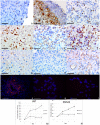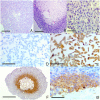Recapitulation of tumor heterogeneity and molecular signatures in a 3D brain cancer model with decreased sensitivity to histone deacetylase inhibition
- PMID: 23272238
- PMCID: PMC3525561
- DOI: 10.1371/journal.pone.0052335
Recapitulation of tumor heterogeneity and molecular signatures in a 3D brain cancer model with decreased sensitivity to histone deacetylase inhibition
Abstract
Introduction: Physiologically relevant pre-clinical ex vivo models recapitulating CNS tumor micro-environmental complexity will aid development of biologically-targeted agents. We present comprehensive characterization of tumor aggregates generated using the 3D Rotary Cell Culture System (RCCS).
Methods: CNS cancer cell lines were grown in conventional 2D cultures and the RCCS and comparison with a cohort of 53 pediatric high grade gliomas conducted by genome wide gene expression and microRNA arrays, coupled with immunohistochemistry, ex vivo magnetic resonance spectroscopy and drug sensitivity evaluation using the histone deacetylase inhibitor, Vorinostat.
Results: Macroscopic RCCS aggregates recapitulated the heterogeneous morphology of brain tumors with a distinct proliferating rim, necrotic core and oxygen tension gradient. Gene expression and microRNA analyses revealed significant differences with 3D expression intermediate to 2D cultures and primary brain tumors. Metabolic profiling revealed differential profiles, with an increase in tumor specific metabolites in 3D. To evaluate the potential of the RCCS as a drug testing tool, we determined the efficacy of Vorinostat against aggregates of U87 and KNS42 glioblastoma cells. Both lines demonstrated markedly reduced sensitivity when assaying in 3D culture conditions compared to classical 2D drug screen approaches.
Conclusions: Our comprehensive characterization demonstrates that 3D RCCS culture of high grade brain tumor cells has profound effects on the genetic, epigenetic and metabolic profiles of cultured cells, with these cells residing as an intermediate phenotype between that of 2D cultures and primary tumors. There is a discrepancy between 2D culture and tumor molecular profiles, and RCCS partially re-capitulates tissue specific features, allowing drug testing in a more relevant ex vivo system.
Conflict of interest statement
Figures








Similar articles
-
Extracellular vesicles secreted by 3D tumor organoids are enriched for immune regulatory signaling biomolecules compared to conventional 2D glioblastoma cell systems.Front Immunol. 2024 Apr 25;15:1388769. doi: 10.3389/fimmu.2024.1388769. eCollection 2024. Front Immunol. 2024. PMID: 38726003 Free PMC article.
-
Transcriptomic Profiling of 3D Glioblastoma Tumoroids for the Identification of Mechanisms Involved in Anticancer Drug Resistance.In Vivo. 2020 Jan-Feb;34(1):199-211. doi: 10.21873/invivo.11762. In Vivo. 2020. PMID: 31882480 Free PMC article.
-
A three-dimensional microenvironment alters protein expression and chemosensitivity of epithelial ovarian cancer cells in vitro.Lab Invest. 2013 May;93(5):528-42. doi: 10.1038/labinvest.2013.41. Epub 2013 Mar 4. Lab Invest. 2013. PMID: 23459371
-
3D modeling in cancer studies.Hum Cell. 2022 Jan;35(1):23-36. doi: 10.1007/s13577-021-00642-9. Epub 2021 Nov 10. Hum Cell. 2022. PMID: 34761350 Review.
-
Exploring the interaction between extracellular matrix components in a 3D organoid disease model to replicate the pathophysiology of breast cancer.J Exp Clin Cancer Res. 2023 Dec 16;42(1):343. doi: 10.1186/s13046-023-02926-4. J Exp Clin Cancer Res. 2023. PMID: 38102637 Free PMC article. Review.
Cited by
-
A novel 3D in vitro model of glioblastoma reveals resistance to temozolomide which was potentiated by hypoxia.J Neurooncol. 2019 Apr;142(2):231-240. doi: 10.1007/s11060-019-03107-0. Epub 2019 Jan 29. J Neurooncol. 2019. PMID: 30694423 Free PMC article.
-
Application of Synthetic Polymeric Scaffolds in Breast Cancer 3D Tissue Cultures and Animal Tumor Models.Int J Biomater. 2017;2017:8074890. doi: 10.1155/2017/8074890. Epub 2017 Dec 17. Int J Biomater. 2017. PMID: 29599800 Free PMC article.
-
Three-dimensional cell culture: a breakthrough in vivo.Int J Mol Sci. 2015 Mar 11;16(3):5517-27. doi: 10.3390/ijms16035517. Int J Mol Sci. 2015. PMID: 25768338 Free PMC article. Review.
-
Low-Density Lipoprotein Pathway Is a Ubiquitous Metabolic Vulnerability in High Grade Glioma Amenable for Nanotherapeutic Delivery.Pharmaceutics. 2023 Feb 10;15(2):599. doi: 10.3390/pharmaceutics15020599. Pharmaceutics. 2023. PMID: 36839921 Free PMC article.
-
Extracellular glutamate and IDH1R132H inhibitor promote glioma growth by boosting redox potential.J Neurooncol. 2020 Feb;146(3):427-437. doi: 10.1007/s11060-019-03359-w. Epub 2020 Feb 4. J Neurooncol. 2020. PMID: 32020473 Free PMC article.
References
-
- Burdett E, Kasper FK, Mikos AG, Ludwig JA (2010) Engineering Tumors: A Tissue Engineering Perspective in Cancer Biology. Tissue Engineering Part B-Reviews 16: 351–359. - PubMed
-
- Kola I, Landis J (2004) Can the pharmaceutical industry reduce attrition rates? Nature Reviews Drug Discovery 3: 711–715. - PubMed
Publication types
MeSH terms
Substances
LinkOut - more resources
Full Text Sources
Other Literature Sources
Medical

